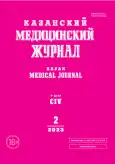Significance of insulin and insulin-like growth factor-1 in the pathogenesis of acne
- Authors: Baytyakov V.V.1, Vlasova S.A.1
-
Affiliations:
- Mordovian State University named after N.P. Ogaryova
- Issue: Vol 104, No 2 (2023)
- Pages: 236-241
- Section: Theoretical and clinical medicine
- Submitted: 26.10.2022
- Accepted: 16.02.2023
- Published: 26.03.2023
- URL: https://kazanmedjournal.ru/kazanmedj/article/view/112094
- DOI: https://doi.org/10.17816/KMJ112094
- ID: 112094
Cite item
Abstract
Background. The potential involvement of insulin and insulin-like growth factor-1 in the pathogenesis of acne may be due to direct stimulation of sebaceous gland cells, an increase in androgen synthesis in the endocrine glands, activation of 5α-reductase, and an increase in the sensitivity of androgen receptors in tissues.
Aim. To study the level of insulin and insulin-like growth factor-1 in women of fertile age suffering from acne; to identify the dependence of these indicators on the clinical and anamnestic features of the disease and the nature of the nutrition of patients.
Material and methods. 60 patients suffering from acne (mean age 23.9±0.92 years) were examined. Clinical indices, reflecting the severity of the skin process and quality of life, were calculated, hormonal status indicators (insulin, insulin-like growth factor-1, total testosterone, estradiol, progesterone) and blood plasma glucose levels were studied. The blood of 30 healthy women (mean age 25.9±1.04 years) was examined as a control. Groups were compared using Student's t-test and odds ratio calculation, correlation analysis was performed using Spearman's rank correlation coefficient.
Results. Patients with acne showed a significant increase in the level of insulin-like growth factor-1 (p=0.0002) and total testosterone (p=0.005). The correlation of the insulin-like factor content with the indices that determine the severity of the skin process and the quality of life of patients was closer than that of the total testosterone. A lower concentration of insulin-like growth factor-1 was noted in the blood of acne patients who followed a diet with restriction of milk and dairy products, foods rich in easily digestible carbohydrates and saturated fats. The level of insulin in patients with acne did not differ from that in the control group.
Conclusion. In women suffering from acne, an increase in the content of insulin-like growth factor-1 in the blood plasma was revealed; at the same time, its level has a closer relationship with the severity of the course of dermatosis and the quality of life of patients in comparison with the indicator of total testosterone.
Full Text
About the authors
Vladimir V. Baytyakov
Mordovian State University named after N.P. Ogaryova
Author for correspondence.
Email: baityakov@rambler.ru
ORCID iD: 0000-0001-5876-0852
M.D., D. Sci. (Med.), Prof., Depart. of Infectious Diseases with Courses in Epidemiology, Phthisiology, Skin and Venereal Diseases
Russian Federation, Saransk, RussiaSvetlana A. Vlasova
Mordovian State University named after N.P. Ogaryova
Email: sveta.vlasova.med@yandex.ru
ORCID iD: 0000-0001-5978-5007
PhD Stud., Depart. of Infectious Diseases with Courses in Epidemiology, Phthisiology, Skin and Venereal Diseases
Russian Federation, Saransk, RussiaReferences
- Layton AM, Thiboutot D, Tan J. Reviewing the global burden of acne: How could we improve care to reduce the burden? Br J Dermatol. 2021;184(2):219–225. doi: 10.1111/bjd.19477.
- Liu P-F, Hsieh Y-D, Lin Y-C, Two A, Shu C-W, Huang C-M. Propionibacterium acnes in the pathogenesis and immunotherapy of acne vulgaris. Curr Drug Metab. 2015;16(4):245–254. doi: 10.2174/1389200216666150812124801.
- Melnik BC, Schmitz G. Role of insulin, insulin-like growth factor-1, hyperglycaemic food and milk consumption in the pathogenesis of acne vulgaris. Exp Dermatol. 2009;18:833–841. doi: 10.1111/j.1600-0625.2009.00924.x.
- Melnik BC, John SM, Plewig G. Acne: Risk indicator for increased body mass index and insulin resistance. Acta Derm Venereol. 2013;93(6):644–649. doi: 10.2340/00015555-1677.
- Manhylova TA, Gafarova NH. Metabolic and hemodynamic effects of the growth hormone system — insulin-like growth factor. Terapevticheskiy arkhiv. 2015;87(12):128–133. (In Russ.) doi: 10.17116/terarkh20158712128-133.
- Vora S, Ovhal A, Jerajani H, Nair N, Chakrabortty A. Correlation of facial sebum to serum insulin-like growth factor-1 in patients with acne. Br J Dermatol. 2008;159(4):990–991. doi: 10.1111/j.1365-2133.2008.08764.x.
- Cappel M, Mauger D, Thiboutot D. Correlation between serum levels of insulin-like growth factor 1, dehydroepiandrosterone sulfate, and dihydrotestosterone and acne lesion counts in adult women. Arch Dermatol. 2005;141(3):333–338. doi: 10.1001/archderm.141.3.333.
- Edmondson SR, Thumiger SP, Werther GA, Wraight CJ. Epidermal homeostasis: the role of growth hormone and insulin-like growth factor systems. Endocr Rev. 2003;24(6):737–764. doi: 10.1210/er.2002-0021.
- Berensztein EB, Baquedano MS, Pepe CM, Costanzo M, Saraco NI, Ponzio R, Rivarola MA, Belgorosky A. Role of IGFs and insulin in the human testis during postnatal activation: Differentiation of steroidogenic cells. Pediatr Res. 2008;63(6):662–666. doi: 10.1203/PDR.0b013e31816c8ffc.
- Fan W, Yanase T, Morinaga H, Okabe T, Nomura M, Daitoku H, Fukamizu A, Kato S, Takayanagi R, Nawata H. Insulin-like growth factor 1/insulin signaling activates androgen signaling through direct interactions of Foxo1 with androgen receptor. J Biol Chem. 2007;282(10):7329–7338. doi: 10.1074/jbc.M610447200.
- Podgorska A, Puscion-Jakubik A, Markiewicz-Zukowska R, Gromkowska-Kepka KJ, Socha K. Acne vulgaris and intake of selected dietary nutrients — a summary of information. Healthcare. 2021;9:668. doi: 10.3390/healthcare9060668.
- Garaeva ZSh, Yusupova LA, Yunusova EI, Mavlyutova GI, Ibragimova LG. The role of nutrition in the pathogenesis of acne. Lechaschi Vrach. 2021;6(24):44–47. (In Russ.) doi: 10.51793/OS.2021.24.6.009.
- Burris J, Shikany JM, Rietkerk W, Woolf K. A low glycemic index and glycemic load diet decreases insulin-like growth factor-1 among adults with moderate and severe acne: a short-duration, 2-week randomized controlled trial. J Acad Nutr Diet. 2018;118(10):1874–1885. doi: 10.1016/j.jand.2018.02.009.
- Kochergin NA, Samgin MA, Monakhov SA, Ignat’ev DV. Dermatologic index of acne. Esteticheskaya meditsina. 2004;3(1):62–65. (In Russ.)
- Motley RJ, Finlay AY. Practical use of a disability index in the routine management of acne. Clin Exp Dermatol. 1992;17(1):1–3. doi: 10.1111/j.1365-2230.1992.tb02521.x.
- American Board of Internal Medicine laboratory test reference ranges. https://www.abim.org/Media/bfijryql/laboratory-reference-ranges.pdf. (access date: 25.10.2022).
Supplementary files






